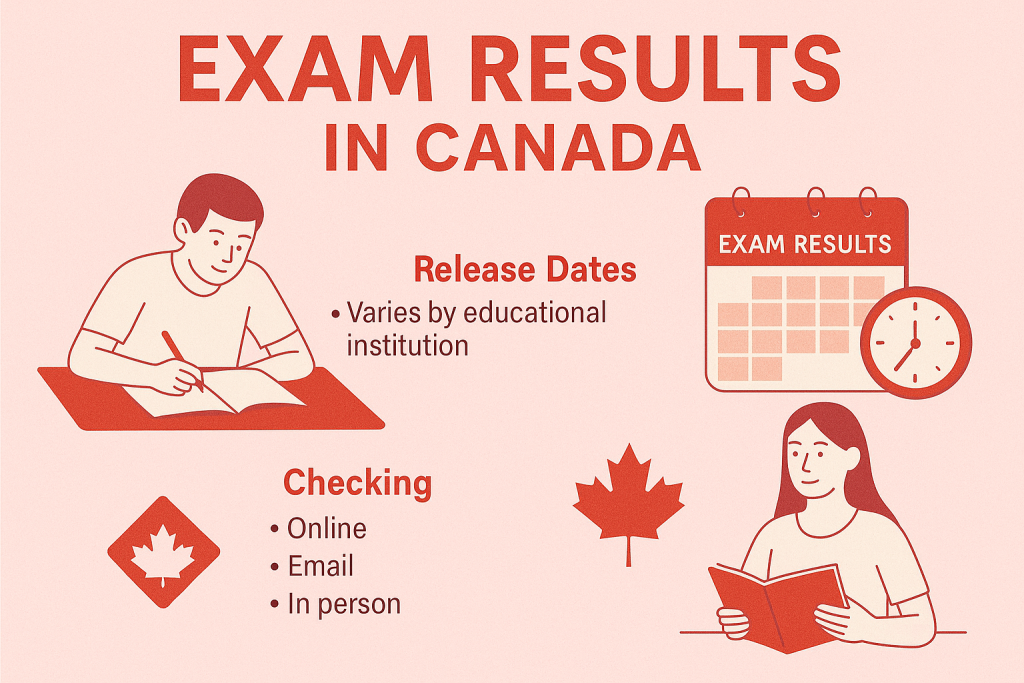In Canada, education varies from province to province, but one thing remains the same: the nerves that come with exam results. Whether it’s high school students waiting for their OSSD scores, university students tracking their GPA, or test-takers checking IELTS or TOEFL, results day always feels heavy. Some students celebrate, while others worry about what comes next. Let’s explore when results are announced in Canada, how students check them, what to do if fear strikes, and why the Canadian exam system is considered flexible and student-friendly.

🗓️ When Results Are Announced
- High School (OSSD & Provincial Exams):
- Ontario OSSD → Results in late June.
- British Columbia & Alberta → Provincial exam results in July.
- Quebec (CEGEP) → R-Scores and grades in early summer.
- University Grades:
- Fall (Sept–Dec) → released in Dec/Jan.
- Winter (Jan–Apr) → released in May.
- Summer (May–Aug) → released in August.
- International Exams:
- IELTS → 13 days.
- PTE → 2–5 days.
- TOEFL → About 6 days.
- GRE/MCAT/LSAT → 3–5 weeks depending on the test.
🔎 How Students Check Results
- Online portals: Schools and universities post results securely online.
- OUAC (Ontario): University-bound high schoolers track results here.
- Emails & Mail: Many institutions still send official notices.
- Printed report cards: Common for high schools.
- International exam websites: IELTS, TOEFL, GRE, and others have their own result systems.
😰 What to Do If Fear or Anxiety Comes
Result anxiety is something nearly every student feels. Here’s how Canadian students cope:
- Keep perspective: Results matter, but they don’t decide your whole life.
- Stay active: Sports, gym, or even a walk helps calm nerves.
- Talk to others: Sharing stress with friends or family makes it lighter.
- Plan ahead: Think about next steps no matter what the score is.
- Avoid comparing: Everyone has a different path – focus on yours.
💡 Motivation Tips
- Reward yourself: Celebrate the effort, not just the outcome.
- Visualize calmly: Imagine opening results with confidence.
- Set future goals: Use your results as a guide for what’s next.
- Stay flexible: Remember, Canada’s system gives you multiple entry routes into education and careers.
📘 Best Books and Resources
- High School: Nelson Education guides, Pearson resources, past provincial exam papers.
- University: Exam banks, lecture slides, and group study sessions.
- International Exams:
- IELTS → Cambridge IELTS books.
- TOEFL → Kaplan and Princeton Review.
- GRE/MCAT/LSAT → Manhattan Prep, Princeton Review, Kaplan.
🌏 Why Canada’s Exam System is Unique
- Province-based control: Each province has its own approach, making it flexible.
- Multiple pathways: Universities, colleges, and apprenticeships are all valued.
- Holistic admissions: Universities look beyond grades – essays and extracurriculars count too.
- Balanced culture: Students are encouraged to join clubs, sports, and community activities alongside academics.
📝 Final Words
Exams are a big part of student life in Canada, but they’re just one part of the story. Whether it’s your OSSD, university GPA, or IELTS score, remember:
- One result doesn’t decide your whole future.
- There’s always another opportunity in Canada’s education system.
- Resilience and consistency matter more than one grade.
So, when results are announced, check them with confidence. No matter what the numbers say, your path forward in Canada is full of possibilities.